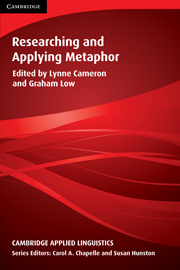Book contents
- Frontmatter
- Contents
- List of contributors
- Acknowledgements
- Conventions
- Series editors' preface
- Preface
- I KEY ISSUES IN METAPHOR RESEARCH
- II FROM THEORY TO DATA
- 4 Getting your sources right: What Aristotle didn't say
- 5 Metaphor and discourse: Towards a linguistic checklist for metaphor analysis
- 6 Identifying and describing metaphor in spoken discourse data
- III ANALYSING METAPHOR IN NATURALLY OCCURRING DATA
- IV ANALYSING METAPHOR IN ELICITED DATA
- References
- Index
6 - Identifying and describing metaphor in spoken discourse data
Published online by Cambridge University Press: 05 October 2012
- Frontmatter
- Contents
- List of contributors
- Acknowledgements
- Conventions
- Series editors' preface
- Preface
- I KEY ISSUES IN METAPHOR RESEARCH
- II FROM THEORY TO DATA
- 4 Getting your sources right: What Aristotle didn't say
- 5 Metaphor and discourse: Towards a linguistic checklist for metaphor analysis
- 6 Identifying and describing metaphor in spoken discourse data
- III ANALYSING METAPHOR IN NATURALLY OCCURRING DATA
- IV ANALYSING METAPHOR IN ELICITED DATA
- References
- Index
Summary
What does it mean to know what a game is? What does it mean, to know it and not be able to say it? Is this knowledge somehow equivalent to an unformulated definition? So that if it were formulated, I should be able to recognize it as the expression of my knowledge? Isn't my knowledge, my concept of a game, completely expressed in the explanations that I could give? That is, in my describing examples of various kinds of game; showing how all sorts of other games can be constructed on the analogy of these; saying that I should scarcely include this or this among games; and so on.
(Wittgenstein, 1953: 1–75)Applying metaphor: issues raised by a ‘prosaic’ approach
Applied metaphor studies cannot avoid the issue of rigorous identification of metaphorical, in contrast to non-metaphorical, language. Identification through defining, by setting up necessary and sufficient conditions for metaphoricity, produces apparently insuperable problems; identification through knowing and describing, in the manner Wittgenstein suggests, would seem a more promising approach. This chapter describes how, for the purposes of a specific applied research study, the unit of analysis ‘metaphor’ was established. It argues that metaphoricity can only in practice be identified relative to particular socio-cultural groups and discourse contexts. Rather than trying to find necessary and sufficient conditions for categorising metaphor, identification began by comparing possible metaphors with noncontroversial, or typical, instances. Boundary criteria were then used to limit the category by excluding doubtful cases of metaphor. A set of graded descriptors was developed for metaphors through a process of interaction between theory and data.
- Type
- Chapter
- Information
- Researching and Applying Metaphor , pp. 105 - 132Publisher: Cambridge University PressPrint publication year: 1999
- 54
- Cited by

